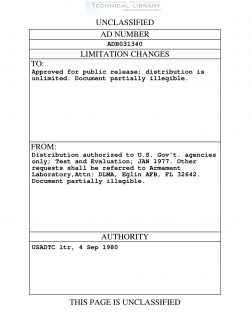AFATL-TR-77-8
- Version
- 240 Downloads
- 23.42 MB File Size
- 1 File Count
- March 1, 2017 Create Date
- March 1, 2017 Last Updated
Aerodynamic Characteristics of 2, 3, & 4, Caliber Tangent Ogive Cylinders with Nose Bluffness Ratios of 0.00, 0.25, 0.50, & 0.75 at Mach Numbers from 0.6 to 4.0

Wind Tunnel The tests were conducted in the AEDC PWT/IT, and VKF/A continuous flow test facilities at the Arnold Engineering Development Center. The (IT) is a 12-inch-square perforated test section. The 40-inch supersonic test faci lity utilizes a solid wall test section. Detailed descriptions of the tunnels are given in Reference I and typical model installations are shown in Figures I and 2. 2. Test Articles The test articles consisted of interchangeable nose, midsection, and afterbody configurations: 20 nose configurations, 4 cylindrical midsections Of fineness ratio ranging from 5 to Il and a I-cal iber cylindrical after- body configuration as shown in Figures 3 and 4. Nose fineness varied from I to 4 calibers. Two-, 3— and 4 -caliber tangent ogive noses (N 14 through N25) were truncated and hemispherical nose caps added to provide three bluffness variations (RN/RB = 0.25, 0.50, 0.75).Grit other means of fixing transition were not used to el iminate the drag increment due to the trip and also incremental drag changes resulting from loss of the grit during tunnel operations. Although only a I-cal iber cylindrical afterbody is eonsidered in this report, various fin configurations were utilized in previous transonic tests (References 2, 3, and 4), which include data for body-cruciform fin configurations with noses NIC), N13, and N14. Scale effects utilizing a larger body-fin configuration in the 4T test facility are shown in Ref- erence 5. A typical assembly of model components is shown in Figure 4 . The cylindrical midsections and noses were fabricated from stainless steel (type 303) with a 32-microinch surface finish. Model configuration iden- tifications are shown in Table l.
| File | Action |
|---|---|
| AFATL-TR-77-8 Aerodynamic Characteristics of 2, 3, & 4, Caliber Tangent Ogive Cylinders with Nose Bluffness Ratios of 0.00, 0.25, 0.50, &.pdf | Download |

Comment On This Post